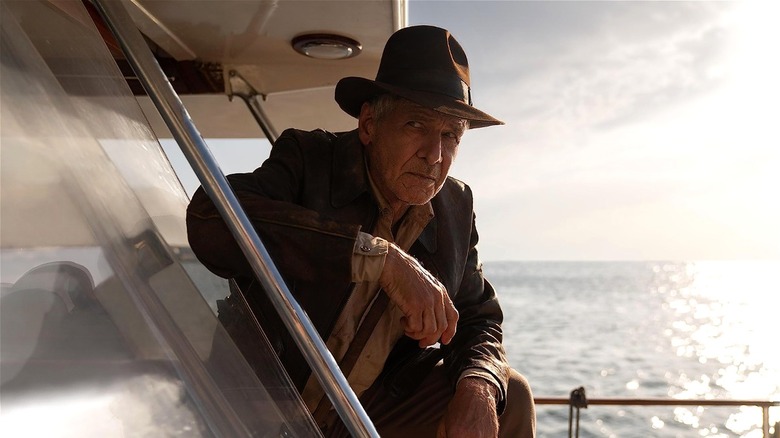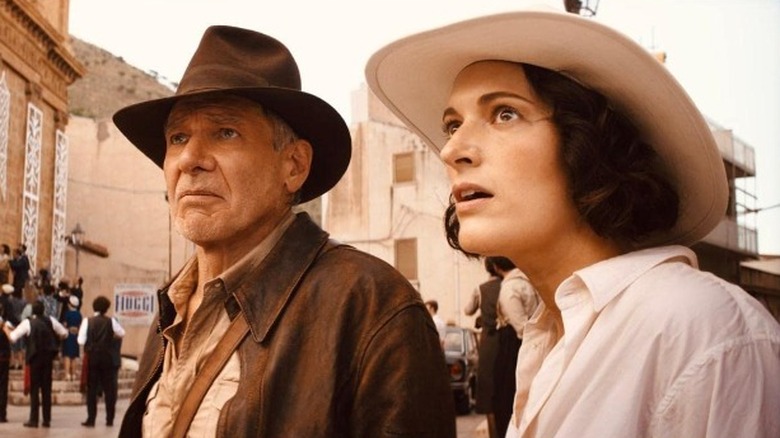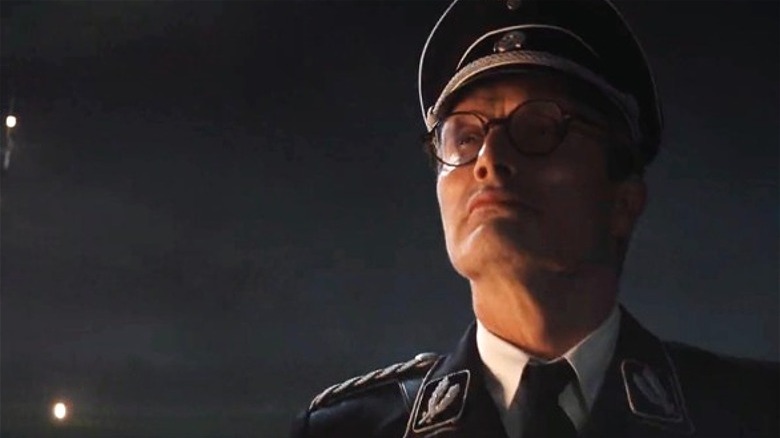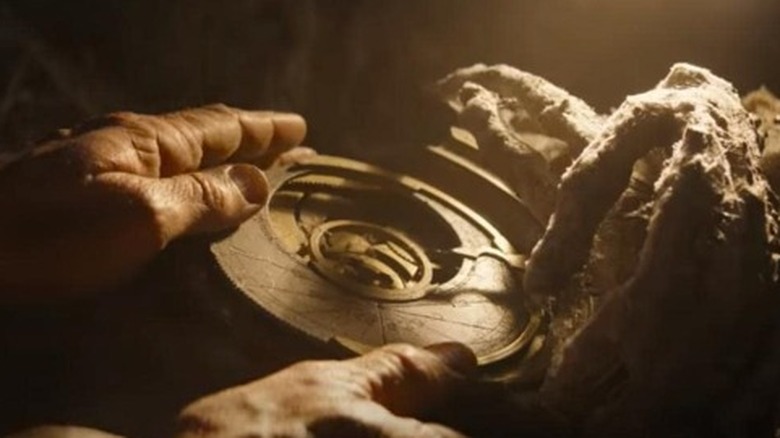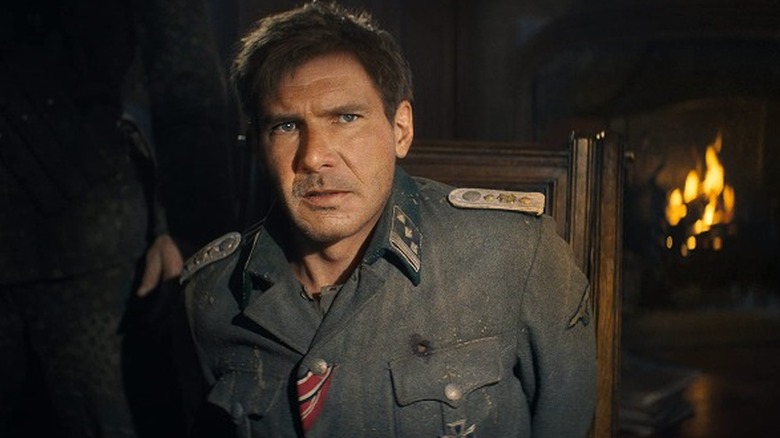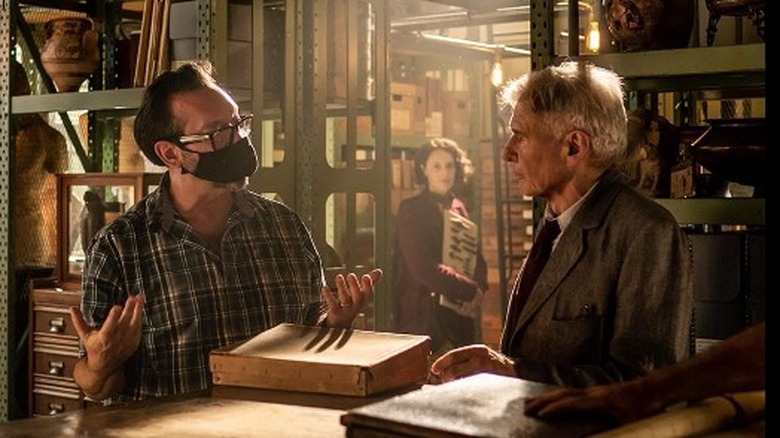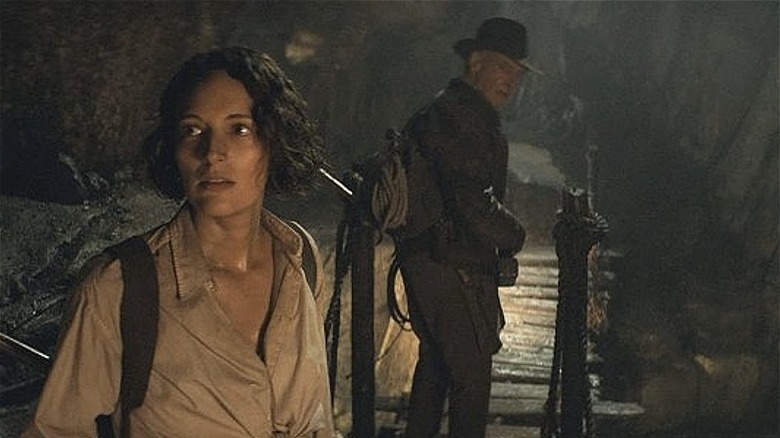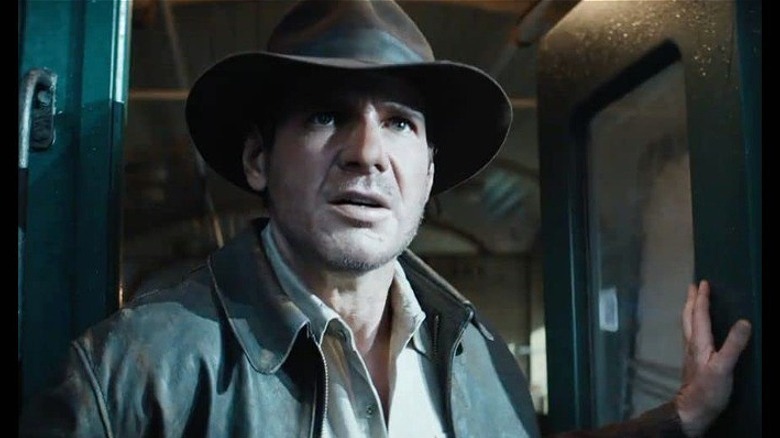The Ending Of Indiana Jones And The Dial Of Destiny Explained
The following contains major spoilers for "Indiana Jones and the Dial of Destiny."
Across five films and 42 years, Indiana Jones (Harrison Ford) has traveled the world and back. However, the franchise's fifth and final film, "Indiana Jones and the Dial of Destiny," sees the daring archeologist go further than ever before. After the sinister astrophysicist Dr. Jürgen Voller (Mads Mikkelsen) attempts to travel back to 1939 in order to kill Hitler and take over the Nazi army, a critical miscalculation hurls the plane through a time fissure to the year 212 BC. Indy and his goddaughter Helena Shaw (Phoebe Waller-Bridge) parachute to safety and find themselves face to face with the legendary Archimedes (Nasser Memarzia). Presented with the miraculous ability to meet one of his heroes, Indy decides to abandon his life in the year 1969 and stay in the past with Archimedes.
However, Helena insists that Indy still has work to do and argues that he must return to his own time. She finally resorts to knocking her wounded godfather out and nursing him back to health in the present. As Indy recovers in his New York City apartment, Helena arranges a heartfelt reconciliation with his estranged wife Marion (Karen Allen). This quiet conclusion may seem like a lackluster final send-off for the legendary adventurer, but director James Mangold grants Indy a peaceful farewell in the twilight years of a tumultuous existence.
What you need to remember about the plot of Indiana Jones and the Dial of Destiny
The fifth chapter in the Indiana Jones saga begins with a trip back in time. We catch up with fedora-wearing treasure hunter in the year 1944 as he escapes a Nazi train filled with stolen antiquities. Fast-forwarding to the year 1969, we're shocked to see that Indy has not only lost his thrill-seeking spirit but his zest for ... everything. He now spends his days yelling at the hippies next door and sleepwalking through his classes at Hunter College. Just days away from retirement, there seems to be little left in the formerly fearless man's life to look forward to.
Fortunately, a new quest falls into Indy's lap when Helena pops up in one of his classes. She claims to be searching for an ancient dial known as the Antikythera possibly used by Archimedes to predict fissures in time. Helena tricks Indy into handing over a piece of this powerful artifact, then dashes off to sell it at auction in Tangiers. Also obsessed with the dial, Dr. Voller steals the valuable antique and draws Indy into a deadly mission to protect his goddaughter and keep the dial out of Nazi hands. Though initially reluctant to get involved in Helena's mess, Indy finds himself falling back into old habits and reuniting with friends from past adventures.
What happened at the end of Indiana Jones and the Dial of Destiny?
Dr. Voller may be able to crack the code leading to the other half of the dial's location, but he makes a crucial mistake when plotting his course through a time fissure. Due to continental drift, the vortex transports his plane back more than 2,000 years to the Siege of Syracuse in 212 BC. Dr. Voller scrambles to reverse his course but the Roman soldiers mistake his plane for a dragon and he finds himself drawn into the battle. Watching from a nearby beach, Indy stares in awe as a legendary war plays out before his eyes, offering secrets to the past any archeologist would dream of discovering. Claiming that his entire life has led to this moment, Indy decides to stay behind and share knowledge with Archimedes. However, Helena insists he still has work to do in the present.
After forcing her godfather to return to his own time, Helena offers a half-hearted apology before slipping out the door to give Indy a moment alone with his estranged wife Marion. Earlier in the film, Indy tells Helena that his son Mutt died in the Vietnam War and his marriage began to crumble in the aftermath of this tragedy. Reunited, the grieving parents embrace each other and take early steps down the path to recovery. As the credits roll, Indy reaches out the window and grabs his iconic hat from the clothesline outside, indicating a return to form for the intrepid archeologist.
Archimedes never traveled through time and Indy shouldn't either
Having determined that the other half of the Antikythera lies in the undiscovered tomb of Archimedes, Indy, and Helena trek through a deadly cave to a hidden crypt. While Indy grabs the dial from the mathematician's skeletal remains, Helena notices an anomaly on the tomb's exterior. A phoenix with modern-day propellers has been carved into the coffin and Archimedes has been buried wearing a 20th century wristwatch. The explorers take this as proof that the illustrious inventor used the dial to travel through a time fissure into the future. We later learn that Archimedes recognized the dial's power for destruction and resisted the temptation to break the barriers of time. Rather than peer into the future, he has merely taken the watch from Dr. Voller's corpse and observed propellers on the wreckage of his downed plane.
Helena argues that Indy's presence in the past will jeopardize the events of recorded history. She refuses to give the inventor a completed version of his own dial, insisting that he finish building it himself. Though disappointed to lose this opportunity to commune with a time traveler, Archimedes appears to understand the wisdom of Helena's argument. He subsequently breaks the dial in two and takes the watch to his grave along with the secrets of its origins. Archimedes likely understands that altering the past will have catastrophic effects on the future, such as Dr. Voller's revised plans for World War II.
Indy still has something to live for
Indy — with his job, marriage, and son all lost — believes he has nothing left in 1969. However, Helena disagrees. Her own father, one of Indy's closest friends, passed away years ago, and the young woman he affectionately calls Wombat needs a father figure. Indy could finally resume his duties as godfather and begin to recover from the pain of Mutt's death. While visiting Sallah (John Rhys-Davies), Indy meets his old friend's grandchildren, who both love to study ancient history. The seasoned archeologist could share his knowledge with these eager students and guide Helena in her own expeditions.
The film concludes with a return to Indy's New York City apartment in 1969, but this time the tiny home overflows with friends and family. Helena's protege Teddy (Ethann Isidore) has been grocery shopping with Marion and Sallah bursts through the door with his two grandchildren ready for ice cream. After decades of excitement and danger, Indy finally has an opportunity to relax in the company of those he loves. The final scene shows a hand grabbing his signature fedora from a balcony clothesline, implying that he has rediscovered his passion for life. However, this does not necessarily mean he will soon dash out the door to hunt for another lost artifact. Instead of traveling back in time to relive his former glory, Indy can concentrate on guiding future generations of archeologists and historians. He does not need death-defying adventure for that life to have meaning.
What has the director of Indiana Jones and the Dial of Destiny said about the ending?
When discussing the film and its quiet ending with Inverse, director and co-writer James Mangold cited the concept of time as his intended theme. "My Indy is a 70-year-old Indy, and so I wanted not just time in the sense of travel, but time in the sense of, I can't undo the mistakes of my past. I can't be the guy I was then because the world has changed around me. Time and all its facets that catch up with us as we get older." The film does feature digital de-aging effects and an impressive sequence that follows a younger Indy at the peak of his physicality, but how many times can the aging professor continue to outwit death? Mangold's movie succeeds in taking audiences back to the handsome professor's heyday, but the film industry and the world have dramatically changed along with the franchise's iconic star.
When describing what he envisions for his hero's final chapter, Mangold told Entertainment Weekly, "I don't think he's done. I think that an ending doesn't mean that the characters never move again in their lives. It just means that you feel that you've entered a state of grace with their story." "Indiana Jones and the Dial of Destiny" feels like a perfect swan song for the beloved swashbuckler. We leave him in a home filled with love and surrounded by multiple generations who will benefit from his wisdom and experience.
What the end of Indiana Jones and the Dial of Destiny could mean for the franchise
The final moments of "Indiana Jones and the Dial of Destiny" could easily be interpreted as a launchpad for another sequel film. However, if another installment ever does materialize, it will do so without the presence of its central star. In an interview with Total Film, Harrison Ford confirmed, "This is the final film in the series, and this is the last time I'll play the character. I anticipate that it will be the last time that he appears in a film." Variety recently reported the possibility of a spin-off series for Disney+, but producer and Lucasfilm President Kathleen Kennedy swears there are no firm plans as of yet.
With Indy out of the picture, the introduction of Helena Shaw presents an interesting angle for possible future iterations. James Mangold created the role with Phoebe Waller-Bridge in mind, believing the English actress possesses the same captivating energy as the saga's first heroine, Marion Ravenwood. Despite this exciting premise, Mangold has made it clear he's not interested in creating future follow-ups, telling Variety "The amount of lore and Easter eggs and fan service starts to become antithetical to any of this stuff at a certain point. It isn't storytelling anymore. It's large-scale advertising." The Indiana Jones saga may continue, but Mangold's film signals a fond, but firm farewell for the director and the world-famous leading man.
Indiana Jones and the Dial of Destiny's alternate ending
This warm, but subdued conclusion feels like a bit of a departure from the action-packed denouements of the original Indiana Jones trilogy. When developing the story, James Mangold originally considered a more traditional final act. "Dial of Destiny" flirts with a return to 1939 and a plot to kill Hilter, an ending that would mirror the film's bravura opening sequence. However, Mangold rejected this narrative direction, telling Inverse, "But the more I sketched that out in my mind, the more that became kind of just a spy movie at the end. I couldn't find a way to emotional resonance."
Mangold's revised conclusion implies relative peace for Indy's twilight years. Continuing the adventures might be tempting, but there's no lasting closure in simply repeating the same quests again and again. We will always have five rousing chapters in the Indiana Jones saga available to revisit whenever we long for a treasure hunt around the globe. However, returning time and again to the same narrative well will only bring diminishing returns. Mangold's finish allows us to say goodbye to Indiana Jones with a promise that our beloved swashbuckler still has happy years ahead of him. Speaking with Entertainment Weekly, Mangold explained that he imagines Indy traveling the world with Marion and "enjoying his life as a retired archeologist." That sounds like a perfect conclusion.
